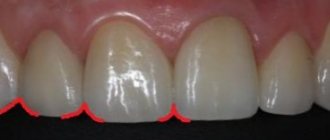Tooth filling is one of the most common and well-established dental procedures, however, it also has its own nuances and subtleties. We tell you what you should pay attention to, what filling to choose and how the filling is installed on a tooth at the ViDentis clinic.
Almost every person has had to deal with a tooth filling in their life. This is a simple and effective procedure, which consists of removing damaged areas of enamel and its further restoration using special compounds. The cost of installing a filling is low, so this treatment is used quite often.
Installing a filling on a tooth: indications
It is recommended to put a filling in dentistry mainly for caries. This is a pathological process that consists of the slow, gradual destruction of tooth tissue under the influence of bacteria contained in soft plaque. As a result of their vital activity, these bacteria produce acids that destroy calcium in tooth enamel. The enamel becomes fragile and is destroyed, forming carious cavities, which, without proper treatment, gradually increase more and more.
By installing a filling on a tooth, you can restore a crown that has been destroyed by caries by about a third. If the tooth tissues are more damaged, then other methods of their restoration are used.
However, caries is not the only reason to get a filling in dentistry. Filling can also correct:
- cracks and chips of enamel;
- traumatic injuries;
- erased enamel (with bruxism).
Which dentist treats caries?
In dental practice, 3 specialists can fill teeth at once:
- Dentist;
- therapist;
- pediatric dentist.
The job description of the first professional includes a wide range of responsibilities. He chooses treatment tactics, administers anesthesia, diagnoses, prevents and treats caries. However, this specialization does not require lengthy training in higher education institutions.
Important! Today, the profession of a dentist is considered obsolete. Their main responsibilities are handled by junior medical staff. Therapists are responsible for diagnosis and treatment.
The pediatrician can also place fillings. However, its focus is the elimination of oral diseases in children.
The dentist-therapist is the first one who receives and examines the patient. This is a generalist. If only conservative intervention is required, it will be handled by a therapist. But when specific therapy is needed, he will refer you to another doctor: an orthodontist, a prosthetist, a surgeon, a periodontist.
Additional Information! A dentist of any specialization is familiar with all manipulations. Therefore, it is not always important which doctor puts the fillings. The procedure may be necessary when performing work of a different nature: prosthetics, orthodontic treatment and other manipulations.
What types of fillings are there?
There are several types of filling materials. The type of material determines the cost of installing a filling on a tooth, how long it will last, and how good it will look.
- Cement fillings have been popular for some time now due to their low cost and ease of use. The main disadvantage of dental cement is its short service life (up to 2 years), as well as its adverse effect on tooth tissue (they can gradually collapse around the filling).
- Plastic fillings are another simple and cheap way to restore a tooth. However, plastic changes color over time and shrinks greatly, ceasing to perform protective functions.
- Composite fillings are the best inexpensive filling option. They have acceptable aesthetics and can last up to 3-5 years.
- Light-curing fillings are one of the most modern and technologically advanced filling methods: the polymer hardens in the light of an ultraviolet lamp. You can quite accurately match the color of the filling to the color of the enamel and make it almost invisible. Yes, these fillings have the highest price, but putting a filling made of photopolymer means solving the issue of restoring a tooth for 5 years or more.
At the ViDentis clinic, patients are offered high-quality light-curing fillings made in America, Japan and Germany.
Materials for filling teeth
Fillings, that is, dental fillings, are made from various materials, which must be completely safe for the patient’s health, durable and aesthetic. Amalgam fillings have been used in dental offices for many years. Because amalgam is a mixture of mercury and other metals, it has been shown to be harmful to the health of patients. The silver or black color of the filling was also not aesthetically pleasing.
Today, modern dental clinics, including Dentik +, use other materials, including: • composite resins - light-curing tooth-colored fillings, less durable than amalgam, • ionomer cements - easily adhere to the tooth, but the white color limits them usage. , • gold is a durable filling, which, however, is not popular due to the lack of color matching.
How does the filling installation process work?
Filling is carried out in several stages.
- Examination and assessment of the condition of the tooth. The doctor determines the size of the lesion and finds out whether the inflammation has spread to the pulp.
- Anesthesia. Tooth filling is carried out under local anesthesia: one or two injections freeze the gum around the diseased tooth and the patient does not feel pain during further manipulations.
- Tooth preparation. The doctor drills the tooth, removing the affected tissue. At the ViDentis clinic, specialists work in binoculars - special microscope glasses in which the smallest details are visible. This allows you to preserve healthy tissue as much as possible, drilling only the areas affected by caries.
- Application of filling material. We use a layer-by-layer technique of applying polymer to the tooth and drying each layer with ultraviolet light. This allows you to achieve high strength and excellent appearance. Aesthetic restoration is also carried out in the same way, when, with the help of filling, for example, a chipped cutting edge of the front teeth is restored. This is the most reliable way to place a filling, and the cost of treatment does not increase.
- Turning and polishing of the filling. To ensure that the filling feels comfortable in the mouth, the doctor grinds off excess material, and so that plaque does not “get stuck” on the surface of the filling, it is polished.
Popular Composite Seals
Composite fillings are commonly used to fill teeth . They consist of active dimethylacrylic polymerizing resins and inactive filler particles. Among the composite fillings the following can be distinguished:
• light-curing fillings, • chemically curing fillings, • thermosetting fillings.
The advantage of their use is high resistance to chewing pressure, high cosmetic qualities, preservation of contrast on X-ray images and excellent adhesion to enamel. They are structurally compatible with tooth tissues.
Does tooth filling hurt?
Pain is the most common factor that prevents patients from visiting the dentist. Even such a simple procedure as filling a tooth can be associated with very serious discomfort. The truth is that it very much depends on the individual patient. Some people are more sensitive to pain and find the sealing procedure very unpleasant. In other cases, patients experience only slight discomfort or nothing at all. Despite everything, modern dentistry offers treatment under anesthesia, so pain is not a problem today.
Restoration of front teeth with veneers
Installing veneers is the best option for restoring front teeth.
A veneer is a thin ceramic plate made from an individual impression in a dental laboratory. Its installation requires minor grinding of the tooth and covers the front surface and cutting edge of the tooth. Veneer - ideally conveys the “pattern” of the tooth surface and matches the color of natural teeth, is not stained by food and lasts more than 10 years.
A veneer can be broken under heavy chewing load, so teeth covered with veneers require a measured load and this type of restoration is not suitable for lateral (chewing) teeth.
If the front tooth has significant damage and the nerve has probably already been removed, the tooth should be restored with a crown.
Preparatory measures
First, the dentist will have to visually examine the defect in the front tooth. If your teeth have decay, you may need to take x-rays. In particularly difficult cases, the nerve may need to be removed. Of course, this happens under the influence of a high-quality anesthetic.
If there is no caries, and the reason for the visit to the dentist is a chipped front unit, then the enamel is cleaned of plaque and tartar is removed. Next comes the filling process itself.
Prevention of caries
The easiest way to avoid fillings or minimize the number of fillings is to visit your dentist regularly. This should be done at least once every six months. Simple tips will also help keep your teeth healthy:
- Careful hygiene. You need to brush your teeth with a high-quality brush and toothpaste at least twice a day.
- Using dental floss will help remove plaque from hard-to-reach places.
- Rinsing with special liquids will also help keep your gums healthy, which play a huge role in keeping your mouth healthy.
- A balanced diet will help ensure you have enough vitamins and minerals to keep your teeth strong.
Now we treat teeth even better!
Treatment, re-treatment of canals, elimination of caries under a microscope without damaging healthy tooth tissue.
We do everything to save your own tooth. Consultation with specialists is FREE!
More details
The use of pin and stump inlays when restoring “dead” teeth
At the beginning of the article, we said that removing the nerve (pulp) deprives the tooth tissue of recharge. In addition to deteriorating the adhesion of dental materials, removing the nerve makes the tooth tissue dry and brittle, and the expansion of the canals during their treatment further weakens the tooth walls.
To make the roots of the tooth stronger, before restoring the tooth, reinforcement of the roots is performed with fonts.
If the supragingival part of a tooth is completely destroyed, then pin-and-stump inlays manufactured in a dental laboratory are used to create a tooth stump, on which a crown is then installed.
Now let’s look at what options there are for restoring “living” teeth.
Should I turn to free healthcare?
The filling is installed not only in private clinics, but also in public clinics. In such institutions you can get a filling at a very low price or completely free of charge. However, the quality of such restoration leaves much to be desired. This is due to several factors:
- Government institutions save as much as possible on everything. For this reason, a minimum number of tools and consumables will be used during the installation of the filling.
- Fillings in free institutions are of the lowest quality. Accordingly, the result and service life are minimal.
- There may be very painful sensations, since low-quality anesthetics are used during the work.
Restoration of anterior teeth using filling material is a budget-friendly way to restore aesthetics and chewing function. Contact only trusted doctors so as not to be disappointed with the result.
Canal treatment methods
The doctor’s task in the treatment of pulpitis and periostitis is to relieve the source of inflammation, suppress the bacterial flora, and clean the canals. And after that, installation of the seal.
Canal treatment methods:
- Therapeutic – used in the early stages of the disease. The dentist will administer the medication, install a gasket, and a temporary filling. After the inflammatory process subsides, it becomes permanent.
- Surgical – removal of the pulp, all affected tissues, cleaning and disinfection of all tooth cavities. After stopping the inflammatory process, the doctor fills the resulting cavities with specialized gutta-percha. Previously, arsenic was used to remove pulp, but this method is no longer used.
Endodontic treatment is sometimes indicated. For example, with abscesses, phlegmons, cysts or granulomas in the root area.
When is a temporary filling required?
A temporary filling is much inferior to a permanent one in terms of strength and durability. It is only needed for a couple of days to keep food and other substances out of the tooth cavity between visits to the dentist. Such a filling can be installed in the following cases:
- — If the root canal treatment was lengthy and the installation of a permanent filling is postponed to the next visit.
- — A temporary filling can serve to hold medication placed in the tooth cavity.
- — If the doctor is not sure that the nerve remains intact. Waiting some time will help you understand whether the tooth can be covered with permanent material.










